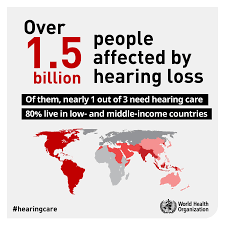
In 2021, the World Health Organization (WHO) released a comprehensive 250-page document on the world’s hearing. Almost any statistic or information you want to know about hearing on a global scale is in this report. But what does it all mean? What can it tell us about our hearing trends in Canada? Well, let’s break down the World Health report on hearing!
Introduction

This document (1) came out of a previous WHO report in 2017. In the original 2017 (2) report, they found that hearing loss was a top unaddressed public health issue all over the world. According to WHO as of 2021 (1), over 1.5 billion people have hearing loss and it’s on the rise. “Hearing care for all.” That is what the WHO is calling for…
“The world report on hearing envisions a world in which no individual experiences hearing loss due to preventable causes and those with hearing loss can achieve their full potential through rehabilitation, education and empowerment.” World Health Organization (2021, pg 1)
To accomplish this, the report broke down into 4 sections…
Section 1: The Importance of hearing across the lifespan
Hearing loss can occur at any age; even though many people perceive it as an ‘old person issue.’ While age is one of the highest causal factors related to hearing loss (WHO, 2021, pg 28-29), it’s not the only one.
Both causal and preventative factors play a role in the probability of acquiring hearing loss. A combination of biological, genetic, environmental, and psychosocial factors. So, hearing loss is then exposure to a causative factor, mitigation through protective factors, and how those express in your body.
Causative Factors (pg 14-29)
- genetic predispositions
- birth trauma
- infections
- loud noise
- smoking
- head trauma
- ototoxic medications/chemicals
- nutritional deficits
- age
- gender
Protective Factors (pg 29-35)
- nutrition
- breastfeeding
- ear hygiene
- noise protection
- immunizations
You can encounter any of these factors throughout life or at specific periods of life. Dependent on when experienced will determine the impacts untreated hearing loss can have on life. This can include language/speech development, communication, education, employment prospects/productivity, social isolation, relationships, etc.
This information points to the risks of hearing loss throughout life, as well as its possible effects if left untreated.
Section 2: Hearing loss can be addressed
Many of the above causes of hearing loss are preventable, with the right strategies, education, and intervention.
By improving access to public health programs, countries can increase practices to prevent but at least detect early hearing loss. The WHO (2021) suggests this can be accomplished through increased awareness, early identification and intervention, education, and implementation of other standard practices.
In Ontario and some other Canadian provinces, infant hearing screenings are standard, ideally, within the first month after birth. The intention of these screenings is to catch any childhood hearing loss and provide intervention within the first 6-months of life. Yet infancy hearing tests are not standardized, leaving it up to the individual to seek-out hearing care as they see fit. For many people, this means not until they notice significant difficulty in hearing.
Increasing preventative public health strategies can help reduce the number of individuals with hearing loss.
Section 3: Challenges in Hearing Care
WHO lays out 3-major challenges countries face in the implementation of the above preventative strategies.
- Population demographics – our aging population is on the rise

2. Hearing Care Stigmatization – Many times hearing loss is ignored or not addressed until later years, perpetuating that hearing loss is an ‘old person issue.’ We are not educated about our hearing health until it’s too late.
3. Health Systems – There are a number of health system ‘blocks’ or part of the infrastructure discussed by WHO (2021, pg 154). Any of these blocks can contribute to challenges in health care.
These challenges point to fundamental inadequacy in many of the world’s health systems; how we educate, provided services, and access to those services.
Section 4: A Public Health Framework
To achieve the goals WHO (2021) has outlined universal health care is key!
” Universal health coverage emphasizes the importance of access both to quality health services and to health information as a basic human right…” World Health Organization (2021, pg 204).
As part of the universal healthcare framework, WHO proposed H.E.A.R.I.N.G. interventions…
H – Hearing screening and intervention
Implementing hearing tests a fixed points in life for timely detection
E – Ear disease prevention and maintenance
Detection and intervention as early as possible
A – Access to technology
Affordable hearing aids and other assistive hearing devices
R – Rehabilitation services
Auditory and speech training for those with hearing loss
I – Improved communication
Access to American Sign Language (ASL), closed captioning, and better education in communication strategies
N – Noise reduction
Education and notification of dangerously loud noise in both occupational and recreational settings
G – Greater community engagement
Changes to attitudes and behaviours by breaking down stigmas
Utilizing these steps and addressing the challenges laid out in Section 3, we can educate, support, and empower those with hearing loss and those who work in the field.
Pulling it all together
So, in Ontario and Canada, what can we do? While we can’t change healthcare policy and practice (unless you’re someone in power to do so!!), we can use this information to guide behaviours toward hearing health. As an individual, this might look like prioritizing the hearing of yourself and your family by getting regular screenings and addressing hearing loss as soon as it occurs. As professionals, we can shift our mindset to preventative, patient-centred care.
The World Health report on hearing provides a very detailed explanation of what hearing looks like around the world and how it can improve. As Canadian citizens, we can take the recommendations and apply them to the best of our ability within the current provincial healthcare system.
For another overview of the WHO 2021 Hearing Report check out this blog from Phonak (3).
References
- World Health Organization (2021). World Report on Hearing. 2021. Geneva, Switzerland.
- World Health Organization. (2017). Global costs of unaddressed hearing loss and cost-effectiveness of interventions: a WHO report, 2017. World Health Organization.
- Gordon, C. (2022, March 1). What does the World Report on Hearing tell us about the future of hearing healthcare? In Phonak Audiology Blog. Retrieved from https://audiologyblog.phonakpro.com/what-does-the-world-report-on-hearing-tell-us-about-the-future-of-hearing-healthcare/



Recent Comments